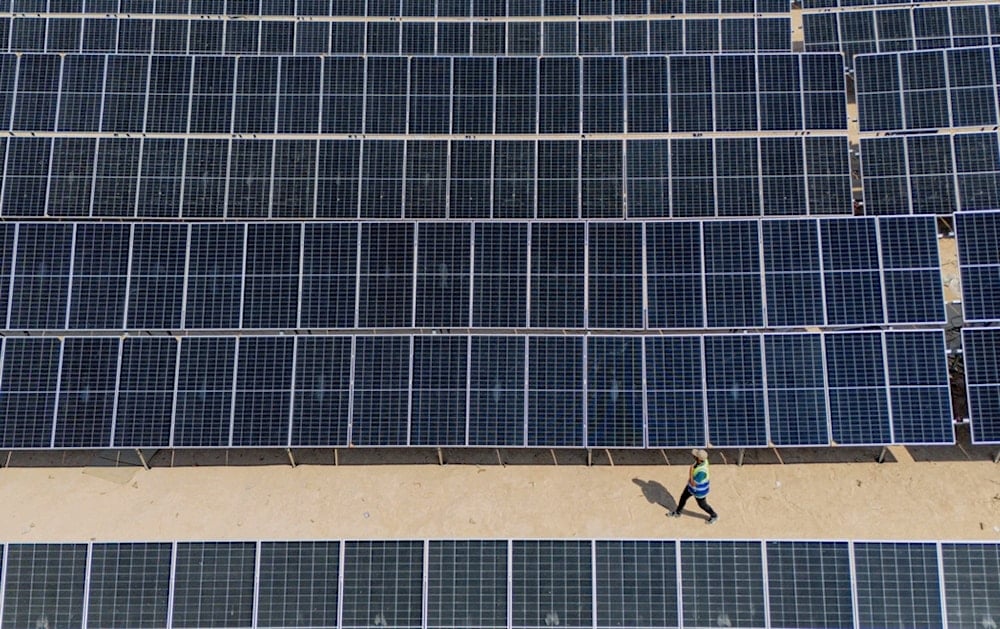Global renewable energy surpasses coal for the first time
A new climate report finds global renewable energy generation from solar and wind has exceeded coal for the first time, marking a major milestone in clean power growth.
-

A worker walks past panels at a newly opened industrial-scale solar power plant in Karbala, Iraq, Wednesday, September 17, 2025. (AP Photo/Anmar Khalil)
For the first time in history, global renewable energy generation from wind and solar sources has surpassed electricity output from coal, signaling a major turning point in the global energy transition.
According to a new climate report by Ember, wind and solar farms worldwide generated more electricity than coal plants during the first half of 2025. The findings mark what analysts are calling a defining moment for the world’s power system.
The report found that renewable energy met the world’s growing electricity demand while fossil fuel use, particularly coal and gas, began to decline.
“Solar and wind are now growing fast enough to meet the world’s growing appetite for electricity,” said Małgorzata Wiatros-Motyka, senior electricity analyst at Ember and author of the report. “This marks the beginning of a shift where clean power is keeping pace with demand growth.”
Read more: China leads global green energy transition, but not without challenges
Solar power drives most of the growth
Solar power led the surge, producing nearly one-third more electricity in the first half of 2025 than during the same period in 2024. It accounted for 83% of the world’s new electricity demand.
Wind energy grew by just over 7%, pushing renewables to outpace fossil fuels globally for the first time. Ember called this a “crucial turning point” in the global power mix.
The shift was most pronounced in China and India, which together accounted for the majority of renewable growth. Both nations saw decreases in coal and gas consumption as clean energy capacity expanded rapidly.
India, China lead global transition
Ember’s data shows China added more renewable capacity in the first half of 2025 than the rest of the world combined, cutting its fossil fuel use by 2% compared with the same period in 2024.
India grew its renewable energy by more than triple its electricity demand, resulting in coal and gas declines of 3.1% and 34% respectively.
While Asia is driving the clean energy surge, the picture elsewhere is more mixed.
In the United States, electricity demand rose faster than renewable generation, leading to a 17% increase in coal use during the same period.
Across the European Union, modest energy demand growth combined with weaker wind and hydropower output forced a small rise in fossil fuel use; gas generation increased by 14%, while coal edged up by 1.1%.
Read more: Chinese $4.2 bln investment to power Brazil’s tech and energy growth
IEA predicts rapid expansion through 2030
The International Energy Agency (IEA) predicts that global renewable energy capacity could more than double by 2030, with solar power expected to provide 80% of that growth.
Fatih Birol, the IEA’s executive director, said, “The growth in global renewable capacity in the coming years will be dominated by solar PV – but with wind, hydropower, bioenergy, and geothermal all contributing, too.”
The IEA forecasts that China will remain the world’s largest renewable energy market, while India will emerge as the second-largest by the end of the decade. Solar growth is also expected to expand in Saudi Arabia, Pakistan, and Southeast Asia.
The findings from Ember’s climate report and the IEA’s analysis highlight a decisive shift in the global energy landscape. With global renewable energy now surpassing coal, experts say the world may have entered a new era, one where clean power not only grows but begins to dominate.
Read more: Greece runs completely on renewable energy for first time

 4 Min Read
4 Min Read











